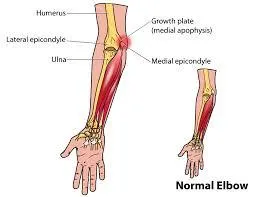
Understanding Little League Elbow: Causes, Symptoms, and Recovery
Little League elbow (also known as Medial Epicondyle Apophysitis) is a common overuse, traction-related injury affecting the growth plate in throwing athletes, aged 8 to 15. Baseball pitchers are more commonly susceptible to this injury due to the large valgus forces placed on the medial elbow during pitching. Repetitive throwing throughout the year (commonly seen in Early Sport Specialization) will lead to this overuse injury at the growth plate. If not addressed early, Little League elbow potentially result in a stress fracture, whch would require non-operative or surgical management depending on the degree of injury. In both of those cases, there is a significant period of being shut down from playing.
Common Signs and Symptoms
Little League elbow typically presents with a set of signs and symptoms that indicate stress and irritation in the growth plate. Athletes may experience:
Loss of Elbow Extension: One of the key indicators of Little League elbow is a decreased ability to fully straighten the elbow. This loss of extension is often due to swelling and inflammation in the joint, which restricts movement. This can affect the player's ability to perform daily activities, let alone throw.
Swelling Along the Medial Epicondyle: The medial epicondyle, located on the inside of the elbow, often becomes swollen and tender to the touch. This swelling is a direct response to the inflammation around the growth plate and is a warning sign that the elbow is under stress.
Pain During Throwing, Especially in the Layback or Acceleration Phase: Pain is usually most pronounced during the throwing motion, particularly during the layback phase (when the arm is cocked back and experiences maximum valgus stress) and the acceleration phase (when the arm moves forward to release the ball, closing down on the inside of the elbow). This discomfort may worsen over time if throwing continues without proper rest and treatment, leading to further damage.
Return-to-Play Guidelines
Treating Little League elbow requires a structured approach to ensure a safe return to sports. The goal is to allow the elbow to heal while gradually reintroducing the stresses associated with throwing. A typical recovery timeline involves two main phases:
Initial Rest and Rehabilitation (5-6 Weeks)
The first step is to stop throwing entirely for approximately 5-6 weeks. During this period, the focus is on reducing pain and inflammation while restoring elbow and shoulder range of motion. Strengthening exercises targeting the shoulder, forearm, core and lower body muscles will also help support the elbow joint and prevent future injuries. After developing a base level of strength, athletes should begin training in the weight room and complete a upper body plyometric progression with the use of medicine and plyo balls to prepare for a return-to-throwing.
Gradual Throwing Progression (6-8 Weeks)
Once the athlete has restored full range of motion and strength, they can begin a gradual throwing program. This phase lasts about 6-8 weeks and involves a carefully monitored progression of throwing distances, intensity, and volume. The goal is to reintroduce the mechanics of throwing while ensuring that the elbow can tolerate the increasing stress. Starting with light tossing and advancing to more demanding throws at greater distances, followed by a mound progression and then working towards pitching in games. Throughout this period, pain or stiffness should be promptly addressed to avoid setbacks.
Prevention Tips
To prevent Little League elbow, young athletes should follow pitch count guidelines, use proper mechanics and avoid pitching for more than 8 months out of the year. Coaches and parents play a crucial role in monitoring pitch counts and ensuring adequate rest to protect young arms from overuse injuries. Encouraging a variety of sports throughout the year rather than specializing in baseball at a young age can also reduce the risk of overuse injuries.
By understanding Little League elbow and following a structured return-to-play plan, young athletes can safely recover and continue to enjoy the sport they love.